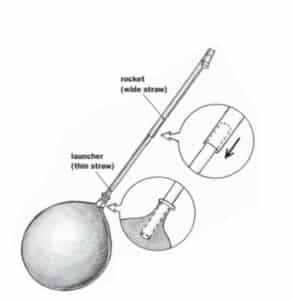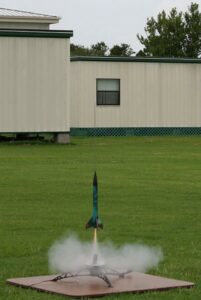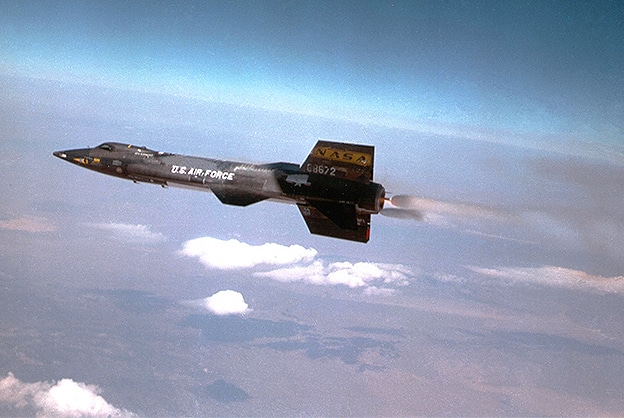Overview
STEM careers
Time
Materials
Supplies & Equipment:
|
Consumables:
|
Relevant Terminology
Gravity: A force of attraction that pulls objects toward each other; in the case of a rocket, the force is pulling it toward the center of the Earth.
Newton’s Third Law of Motion: For every action, there is an equal and opposite reaction. When hot gas shoots out of the bottom of a rocket, it causes the rocket to fly in the opposite direction.
Introduce
GETTING READY

Insert one end of the thin straw into the balloon to make the launcher. The rocket fits over the thin straw. Credit: PBS Kids/Design Squad.
Check that your wide straws easily slip over the thin straws. Smoothie or milkshake straws can range in diameter from 7–9 mm; thin or jumbo straws range 5–6 mm in diameter.
Set up a target and designate a launch zone 5 feet away. You can tape several targets on the wall, or place one on the floor in the center of a circle.
You may wish to organize your materials with the thin straws and balloons in one area and the wide straws, paper, and clay in another. Decide in advance if you want to allow participants to take their rockets and launchers home.
If you know your audience includes children with a latex allergy, purchase some non-latex balloons.
INTRODUCTION
Ask questions to determine what the participants know about how rockets work:
- Have you ever seen a rocket launch? How does it look different from when a plane takes off? (Rocket engines, such as those used by NASA, burn fuel to create hot gas. As this gas is ejected out of the bottom of the engine, the rocket accelerates in the opposite direction.)
- What are some uses of rockets, other than exploring space? (Fireworks, model rocketry, military.)
Instructions

Model rockets use fins to stabilize their flight. Without fins, these rockets would easily tumble and fly off course. Credit: Justin Lebar/Wikimedia
Introduce the design challenge. Explain that participants will build an air-powered rocket launcher and rocket out of everyday materials. Their rocket needs to hit a target 5 feet away.
Provide instructions to the participants.
Build the rocket launcher first.
- Slide a thin straw into the mouth of a balloon. Use tape to seal up any gaps.
- To test your seal, inflate the balloon by blowing through the straw. Build the rocket out of a wide straw. The rocket needs to be open at one end and closed off on the other.
- Plug one end with clay, fold the end over and secure with tape, or design another way of closing off one end.
- Add paper fins to the rocket.
Test your rocket.
- Inflate the launcher and pinch off the balloon to keep it inflated.
- Slide the rocket onto the thin straw of the launcher.
- Aim the rocket and, holding on to the rear of the balloon, release your pinched fingers.
- Make adjustments to your design until the conditions of the challenge are met. Experiment with size, shape, number, and orientation of fins and observe how they influence the rocket’s flight.
Evaluate the success of each design.
- Did the launcher allow air out through the straw only, or did air escape some other way?
- Was the rocket able to fly 5 feet?
- Could the rocket consistently hit the target?
ACTIVITY VARIATIONS
Try to build the rocket that goes the highest.
Experiment with different launching mechanisms. Use your imagination to convert plastic bottles, bicycle pumps, or anything else into a rocket launcher.
Use clay to place weight at different points along the rocket and better control its flight. What configuration works best?
Use the rockets to investigate the effect of gravity on projectiles.
TROUBLESHOOTING
If the rocket doesn’t fly far enough:
- Adjust the launch angle.
- Inflate the balloon more.
- Decrease the rocket’s weight.
If the rocket doesn’t fly straight:
- Add fins for stability (at least three fins are required for stable flight).
- Add a small amount of weight at the tip of the rocket (this moves the center of mass forward, which provides mass stabilization).
If the rocket doesn’t launch at all:
- Make sure the straws are dry.
- Use a wider straw for the rocket.
Guiding questions
GUIDANCE FOR YOUNGER CHILDREN
QUESTIONS TO ASK AFTER THE ACTIVITY
- What made your rocket take flight?
- Were you able to hit the target consistently with your rocket?
- Did you add anything to your rocket that made it fly better, or fly worse?
- If you added fins to your rocket, how many did you add and why?
- How did adding fins change the flight path of your rocket?
- Did you change the amount of air in the balloon or the angle of your launch? Why or why not?
GUIDANCE FOR OLDER YOUTH AND ADULTS
QUESTIONS TO ASK AFTER THE ACTIVITY
- What factors did you consider while designing your rocket?
- Did you add fins or make any other modifications to your design? Why or why not?
- If you added fins, how many were required to stabilize your rocket?
- If you added clay, how much was needed to stabilize your rocket?
- How does changing the size of the balloon affect the trajectory of the rocket?
- Which launch angle provides maximum range?
Engineering & science connections
GUIDANCE FOR YOUNGER CHILDREN
Engineering Connections
When engineers design rockets, they think about how to get the rocket off the ground. They also think about how to control the rocket once it is in flight. The first time you launched your rocket, did it follow a smooth, curved path? If not, it might have something to do with the shape of your rocket. Engineers design rockets with fins to help control the rocket’s flight.
Science Connections
If you blow up a balloon and let it go, the air inside will be pushed out of the opening and the balloon will go flying. Notice that the balloon flies in the opposite direction that the air comes out. Rockets work the same way: hot gas is pushed out of the bottom of a rocket, and the rocket flies up in the air. This is an example of Newton’s Third Law of Motion.
GUIDANCE FOR OLDER YOUTH AND ADULTS
Engineering Connections
When engineers design rockets, they think about how to get the rocket off the ground. They also think about how to control the rocket once it is in flight. The first time you launched your rocket, did it follow a smooth, curved path? If not, it might have something to do with the shape of your rocket. You may have noticed that many real rockets have fins, wings, or other parts that help control a rocket’s flight.
Fins and wings have their own surfaces. When you add these surfaces to a rocket, you increase the surface area, or the area catching the wind toward the tail of the rocket. These fins work like the tail on a kite, which keeps the front of the kite facing in the exact direction that you want. What if you could move the kite’s tail in any direction you chose? If you moved the tail one way, the nose would move in the other direction. In the same way, being able to adjust a rocket’s fins makes it possible for pilots to control the flow of air around the rocket, and therefore direct its motion.
Science Connections
According to Newton’s Third Law of Motion, “For every action, there is an equal and opposite reaction.” This means that any applied force will experience an opposing force of the same size but in the opposite direction. This principle is what allows us to launch rockets into space. In order for a rocket to leave the launch pad, it must release gas from its engine. This gas is created by burning solid or liquid fuel. The action that triggers the launch of the rocket is the release of gas from the engine, which is called thrust. As the rocket pushes the gas away (down), the gas pushes back on the rocket (up) with an equal force. As a result, the rocket moves in the opposite direction. This is the reaction. If the force of the thrust is greater than the weight of the rocket, then the rocket will lift off of the launch pad.
This “Launch It” activity was adapted from the On the Moon Guide, produced by the WGBH Education Outreach department in collaboration with the National Aeronautics an Space Administration (NASA), pbskids.org/designsquad/parentseducators/guides/index.html. Used with permission from WGBH Educational Foundation.
Major funding for Design Squad is provided by the Corporation for Public Broadcasting (CPB) and Intel Education Foundation. Additional funding is provided by the National Council of Examiners for Engineering and Surveying, United Engineering Foundation, Noyce Foundation, Northrop Grumman Foundation, and IEEE. ©2008 WGBH Educational Foundation. Design Squad and logo are trademarks of WGBH Educational Foundation. All rights reserved. This Design Squad activity was produce through the support of the National Aeronautics an Space Administration (NASA)
Supplemental content adapted for Dream Big Activities by Carnegie Science Center.


0 Comments